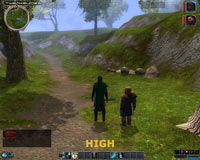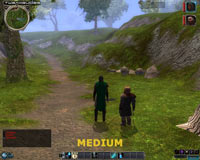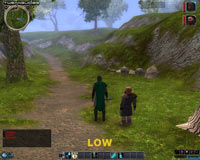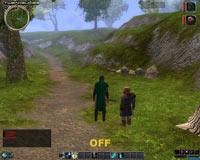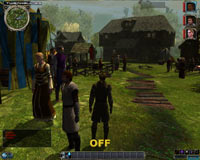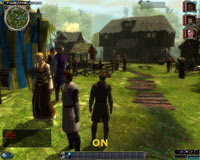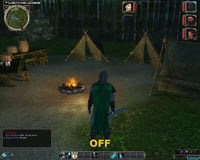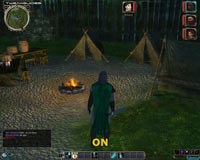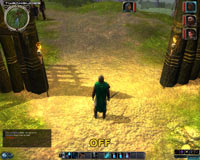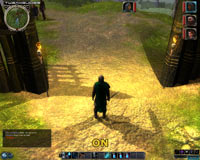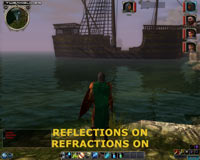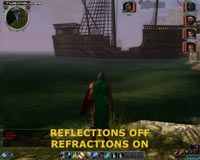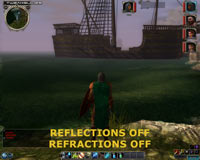Neverwinter Nights 2 Tweak Guide
[Page 5] In-Game Settings
In this section I provide full descriptions, comparitive screenshots and recommendations for NWN2's in-game settings, allowing you to determine your personal balance between image quality and performance. While I try to note the performance impact of each setting, it is impossible for me to give exact performance impacts (e.g. a 10% rise in FPS) because it all depends on your specific hardware combination and your other game and system-wide settings in combination. Each system is unique in the combination of components it has, so two people with the same graphics card but different CPUs for example may experience very different FPS results in certain scenes.
To access the in-game settings start Neverwinter Nights 2 and on the main menu screen select Options. The many settings available are covered in detail below. If you can't see certain settings make sure you've updated to the latest version of the game (See page 4 for details):
Update: As of the 1.10 Patch, the in-game options screens have had a significant number of changes - entire sections have been renamed or added, and many options within each section have been added, removed, renamed and/or shifted around. The changes won't be noted individually as there are far too many of them. I recommend you re-read this section of the guide to get across the changes.
Character Mode & Strategy Mode
Character Mode is a 'follow behind' camera mode most suitable mode for controlling an individual character; Strategy Mode is a 'top down' camera mode more suitable for controlling the party. By default you can switch between Character and Strategy modes at any time by using the numeric keypad * key. Most of the options on these two screens are the same as each other, however obviously they will impact on your controls and camera only when in the relevant mode.
Furthermore, most of the settings in this area have a clear popup description which can be seen when you hold your mouse over the option selection box. Therefore below I only cover the settings which actually have a performance impact, or are not readily understandable. Note that as a general rule, Character Mode will result in lower FPS because it provides a greater view of your surroundings into the distance, as well as greater detail for objects and characters nearby.
Ceilings Always On/Off: When enabled this option controls whether ceilings are visible or not in the relevant modes. When ceilings are turned off, you can move the camera beyond the ceiling, when ceilings are on the camera can move no further than the ceiling. There will be a performance impact if ceilings are turned off and the camera is moved back to show more on screen, but you should choose the option which best suits your playing style.
Object Fade: This option is essentially designed to prevent solid objects from getting in the way of your view when controlling characters. It means that various solid objects in the game world fade into near-invisibility when in the way, though they are still solid objects for movement purposes. Whether this suits your tastes or not is up to you, but in performance terms, paradoxically enabling Object Fade can actually reduce your FPS. This is because the transparency effect used for faded objects can be a bit more strenous to draw than simply drawing the solid object itself. Note that you can set the level of transparency using the ObjectFade Percentage setting in the Advanced Tweaking section.
Graphics
The options in this section have significant impact on framerate in the game.
Screen Resolution: This setting allows you to choose the resolution for the game, as shown in pixel width by pixel height. The options shown are restricted to those supported by your particular combination of monitor and graphics card. The higher the resolution chosen, the lower the performance of the game. For more details on resolution see my Gamer's Graphics & Display Settings Guide. Note that raising resolution not only lowers performance, it also reduces the size of the game's user interface elements.
Note: If you find most of your supported resolutions are missing, and you are using a refresh rate override utility like Refresh Force, disable or return the refresh rates to default to fix this.
Antialiasing Mode: This setting controls the sample rate for antialiasing, a feature which reduces the jaggedness of lines in the game. The available options here are 0x, 2x and 4x, with the higher the sample rate, the lower the performance. More details and screenshot comparisons of antialiasing are on this page of my Gamer's Graphics & Display Settings Guide. Antialiasing is one of the first things you should disable if you need extra FPS, as it can noticeably reduce performance on all but the latest high-end graphics cards.
Texture Quality: This setting controls the level of detail shown in textures, which form the surface of everything in the game world. Note that texture detail is also greatly affected by the Texure Minification, Magnification, and Texture Anisotropy settings so see those further below. To see an animated screenshot comparison click this link: NWN2_TextureResolutions.gif (585KB). Note the detailing on the ground, on the chimney and even the chairs and wall in the background are all very crisp and clear at High, but at Medium these become blurrier, and at Low even more so. Lowering texture resolution can help in both increasing performance and reducing stuttering in the game, particularly on graphics cards with only 128MB of Video RAM.
Shadow Options: This setting controls the various types of shadows cast in the game world, and is of critical importance. The game engine seems to struggle with rendering shadows, such that on most systems changing this setting will result in noticeable FPS impacts, especially when combined with the Point Light Shadows, Softer Shadows, and Shadow Quality settings covered further below. The four options here are High, Medium, Low and Off, and the screenshot comparison above details the differences. At High most items in the game world cast shadows, including the characters, as well as trees, rocks and buildings (so called 'environment shadows'). At Medium all environment shadows are disabled, leaving the character shadows as the most prominent shadows visible. At Low, all shadows are disabled, except for indistinct 'blob' shadows for characters. At Off, all shadows are disabled.
Clearly as this setting is reduced, the realism and atmosphere of the game also diminishes, but framerate can rise significantly, especially during heavy combat when multiple spell effects or light sources can cast many shadows. The important thing to note about Shadows is that its impact is greatly determined by the four other shadow and lighting-related settings mentioned above. It is quite possible to enable High Shadows for example and still have playable framerates if you lower the Shadow Quality settings, or turn off Softer Shadows, Point Light Shadows and/or Render Far Shadows to improve general shadow performance. The bottom line is you will need to experiment with this all-important setting in conjunction with the other related settings to arrive at a suitable balance of image quality and performance. You don't necessarily have to turn off shadows altogether. However on its own, turning Shadows off can double your FPS, so if you're truly struggling for performance then Low or Off is a must.
Gamma Correction: The slider controls the level of overall brightness or darkness of the game image - set to suit your taste as it has no performance impact.
Bloom Effects: Bloom effects change the quality of the lighting to create a more saturated, richer and hazier looking game world. The screenshot comparison above demonstrates the difference between enabling or disabling this option in NWN2. If bloom is not to your taste, you can disable it to gain a few FPS, however aside from making the game world seem more vibrant, it also works to reduce the appearance of aliasing (jaggedness) at far less impact than enabling Antialiasing. Note that the more advanced HDR lighting can't be enabled in NWN2; even though there is a UseHDRIfAvailable setting it does not currently work.
Normal Mapped Terrain: If enabled, allows the use of Normal Maps on terrain. This means that the terrain will appear more realistic in the way it reacts to lighting and have greater depth and texture. The screenshot comparison above demonstrates the difference; note the ground clearly has more depth and texture due to the light from the campfire with this option enabled. While the FPS impact may not be great on newer systems, if you have an older graphics card you can turn this option off for extra FPS.
Render Grass: This option toggles whether grass is shown or not. By disabling grass you can gain a significant boost in FPS in certain outdoor areas, so untick this if required.
Point Light Shadows: This setting controls whether or not Point Lights - that is single points of light such as torches, as opposed to global points of light like the sun - can cause objects to cast shadows (If Shadows are enabled - see above). The screenshot comparison above demonstrates that when enabled, the two torches in the scene each cause my character to have three shadows: one from the sun, and one from each torch. There are also shadows cast by the walls due to the torches. This will reduce performance in scenes with one or more point light sources, again the amount depending on how many light sources and how many objects there are in the scene. For example a heavy combat scene with multiple characters and several torches would mean a very significant FPS drop if this setting is enabled.
Softer Shadows: If Shadows are enabled, this option reduces the sharpness of shadows as its name implies. This softening effect can reduce FPS (depending on how many shadows are being cast), and in my opinion also makes shadows look worse by blurring and removing their detail and richness.
Show Lights Carried by Companions: If enabled, party members which are not currently under your control can cast light from magic items for example. If disabled, only your currently controlled character casts light. Disabling this option can help improve performance if your other party members do indeed have items which cast light (torches aside), but only if you have any Shadow options enabled.
Water Reflections: This setting controls whether reflections are shown on the surface of water. In areas where water is visible, disabling this setting can noticeably improve performance at the cost of some realism. The screenshot comparison above shows the impact of this setting.
Water Refraction: This setting is supposed to control the way in which objects appear distorted when under water. However in my experimentation I found it makes little difference to distortion when enabled or disabled, and indeed the FPS impact is not major as well. The screenshot comparison above shows that with Refraction turned off (and Reflections Off to better show the impact), the only real difference is that the bottom of the ship under the water is gone. The rocks under the water still show distortion effects.
Wait for Vertical Sync: Vertical Synchronization (or VSync) is covered in plain English both here in my Gamer's Graphics & Display Settings Guide, and also on the last page of this guide. Prior to this setting being introduced to NWN2, VSync was always enabled, which can result in significantly reduced performance. Now you have the option of disabling it by unticking this box, and I generally strongly recommend that most people do just that. Alternatively, you can enable it, but you should then also enable Triple Buffering to prevent performance problems.
Always Draw Transitions: If enabled, the 'Area Transition' trigger icon - the world map for traveling around from area to area for example - will always be drawn. If disabled, it will only appear as you get close to it or put your mouse over it.
The next page continues our look at Neverwinter Nights 2's In-Game Settings.

